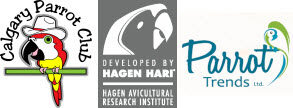Wing Clipping
Too often I see parrots with excessively clipped primary and secondary feathers. Could you offer some basic guidelines on the correct method for clipping a bird’s wings?
I couldn’t agree more. Far too often, we see birds with injuries, both physical and emotional, from poor wing clips. In our practice, we feel each bird should be evaluated individually for the type of wing clip that best suits it.
Factors that should be considered include age, species, weight, and environmental circumstances. In general, the purpose of a wing clip is to prevent a bird from gaining or maintaining altitude. After a wing clip, a bird should be able to gently glide down to a surface. In general we always recommend a symmetrical wing clip (same on both sides). The only feathers that should be trimmed in a wing clip are the primary feathers (the first 10). Wing clips should never proceed into the secondary feathers. Variations of how many primary feathers, how short the primary feathers and in what order the primary feathers are trimmed are determined by the individual bird. Aerodynamic light weight birds such as Conures or Cockatiels will usually need a more aggressive wing clip (cut the first 6 – 8 primaries short in a ‘block cut’) to keep them grounded. Leaving even one end feather per side can be enough for some birds to get lift off! Heavier birds such as Amazons or African Greys often do better with a modified cut, taking some and leaving some of the primaries. We liken it to creating a few ‘holes’ in the wing of plane – enough to glide, but not enough to flap and get loft.
We always recommend birds with new wing clips be placed on the ground to do a few ‘false starts’ and get the idea they cannot fly. It is better to take fewer feathers initially and ‘take more’ as needed (ensuring the bird cannot injure itself) – as there is no putting back what you cut off!! We advise owners to come in for a wing clip demonstration prior to trimming wings at home. This way, the individual bird’s circumstance can be assessed, the best wing clip recommended and owners can be taught how to recognize a blood feather (a new feather that is growing in, has a blood supply and should NEVER be cut).
For birds that are recovering from a bad wing clip, we discourage sitting high on a cage top or on an owner’s shoulder. If the bird is prone to flapping around (young Cockatiels/African Greys) we recommend rearranging the cage so that the bird cannot injure itself on the perches or the floor as it flutters down. Always avoid doing aggressive nail trims on birds with poorly cut wings to ensure that their grip is maximized while their balance is compromised.
Respectfully submitted,
Dr. Kerry Korber
Calgary Avian & Exotic Pet Clinic
